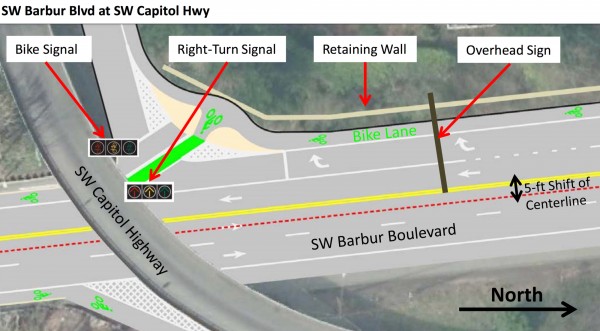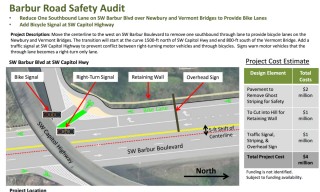Yesterday the Oregon Department of Transportation did something unprecedented: they officially proposed re-allocating lane space on on Southwest Barbur Boulevard to make less room for driving and more room for cycling. Here are their exact words: “Reduce one southbound lane on SW Barbur Blvd over Newbury and Vermont Bridges to provide bike lanes.”
This great news came in an announcement yesterday that came with the release of new documents published by ODOT in response to the Barbur Road Safety Audit that came out back in October. The audit was performed by a private consultant and it included some significant findings on how to improve cycling access on this major arterial street that’s the most direct connection from southwest Portland into downtown. One of its ideas, which we highlighted in detail a few days after the audit was released, has now been embraced by ODOT and is part of an official package of proposed improvements they’d like to move forward on.
There’s a lot to digest in ODOT’s response to the audit; but the big one has to do with the southbound section near SW Capitol Highway, just north of the Newbury Bridge. As we reported last fall, traffic data shows that 40 to 50 percent of southbound Barbur auto traffic exits at Capitol. This fact makes it reasonable to re-stripe the roadway space from the existing two standard lanes (that force bicycle riders to merge with auto users) into one standard lane and one bike-only lane. In addition to the lane re-striping, ODOT would add a bicycle-only signal at Capitol Highway to improve safety at this high-risk and high-speed intersection. Here’s the full project description followed by a screenshot of the document:
Move the centerline to the west on SW Barbur Boulevard to remove one southbound through lane to provide bicycle lanes on the Newbury and Vermont Bridges. The transition will start at the curve 1500-ft north of SW Capitol Hwy and end 800-ft south of the Vermont Bridge. Add a traffic signal at SW Capitol Highway to prevent conflict between right-turning motor vehicles and through bicycles. Signs warn motor vehicles that the through lane becomes a right-turn only lane.
Advertisement
At this point, ODOT isn’t breaking ground or anything. And they haven’t allocated the $4 million it’ll take to do this work. But the fact that ODOT has now officially acknowledged the need for a road diet on Barbur is a very big deal. It’s a victory for all the advocates and electeds who have pushed for changes on Barbur over the years.
Speaking of which, we first shared a grassroots effort to make Barbur better for cycling in 2010 when a pair of Portland State University students started a Friends of Barbur group. The three years later the idea came roaring back into the news when ODOT released plans to rehabilitate the Vermont and Newbury bridges. Advocates — including the Bicycle Transportation Alliance who made this one of their top priorities — seized on that project as a perfect opportunity to re-stripe the road and put a separated bikeway over the bridges. As crashes and tragedies continued to happen, pressure mounted on ODOT to put the road on a diet but they resisted at every turn.
The road safety audit conducted last summer was the big breakthrough (and it helped that it was pushed for by State Representative Ann Lininger). This past November the pressure reached a breaking point when Portland Transportation Commissioner Steve Novick and U.S. Congressman Earl Blumenauer both urged ODOT to act.
This project is far from a done deal, but this breakthrough is worth celebrating. And it took endless pressure from many corners — from grassroots activists to the Bicycle Transportation Alliance and even the city’s own Bicycle Advisory Committee.
Stay tuned for more on this story. For now, peruse ODOT’s full response and list of projects they want to implement on Barbur in the coming years at Oregon.gov.
— Jonathan Maus, (503) 706-8804 – jonathan@bikeportland.org
BikePortland can’t survive without subscribers. It’s just $10 per month and you can sign up in a few minutes.



